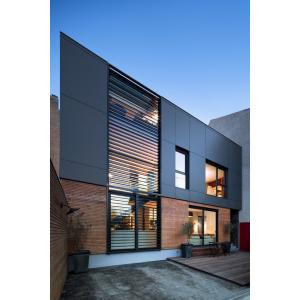Decorative Perforated Outdoor Panels Designs Aluminium Curtain Wall
Aluminum curtain wall:
1. Thermal Performance: Energy efficiency is a crucial consideration in building design. Curtain walls can be designed to enhance thermal performance by incorporating features such as low-emissivity (low-e) coatings, thermal breaks, and insulated glass. These elements help to minimize heat transfer through the curtain wall, improve indoor comfort, and reduce energy consumption for heating and cooling.
2. Structural Movement: Buildings are subject to movement due to factors such as wind, seismic activity, and thermal expansion and contraction. Curtain walls must be designed to accommodate these movements and prevent excessive stress or damage. Expansion joints, flexible connections, and careful detailing are employed to allow for the required movement while maintaining the integrity of the curtain wall system.
Product Description:
Building Codes and Regulations: The design and installation of curtain walls are subject to local building codes and regulations. These codes specify requirements related to structural performance, fire safety, wind loads, energy efficiency, and accessibility. Compliance with these codes is essential to ensure the safety and functionality of the curtain wall system.
Testing and Certification: Curtain wall systems often undergo rigorous testing to evaluate their performance under various conditions. These tests may include air infiltration, water penetration, structural integrity, and impact resistance. Certification programs, such as those provided by independent organizations, can offer assurance of a curtain wall system's compliance with industry standards and performance criteria.
The production of aluminum facades involves a relatively low environmental impact. Aluminum is derived from bauxite, a naturally occurring mineral, and the extraction process is energy-intensive. However, aluminum is highly recyclable, and recycling aluminum requires significantly less energy compared to primary production. Choosing aluminum facades with recycled content further reduces the carbon footprint associated with their manufacture.
Applications and Industries:
1. Low Maintenance: Aluminum facades require minimal maintenance throughout their lifespan. The material is resistant to rust and corrosion, eliminating the need for regular painting or protective coatings. Aluminum facades can be easily cleaned with mild detergents and water, keeping them looking aesthetically pleasing with minimal effort.
2. Design Flexibility: Aluminum facades provide architects and designers with a wide range of design possibilities. The material can be shaped, bent, and formed into various profiles, including flat panels, corrugated sheets, perforated panels, and customized shapes. This flexibility allows for creative and unique facade designs.
3. Aesthetic Appeal: Aluminum facades can enhance the visual appeal of a building. The material can be finished with different coatings, such as anodizing or powder coating, to achieve a desired color, texture, or metallic finish. Additionally, aluminum panels can be perforated or patterned to create interesting visual effects and play with light and shadow.
4. Durability and Maintenance: Aluminum facades are highly durable and long-lasting. Aluminum is resistant to rust and corrosion, which helps maintain the facade's appearance over time. The material is also low-maintenance, requiring minimal cleaning and upkeep.
5. Design Flexibility: Aluminum facades offer excellent design flexibility, allowing architects and designers to create unique and visually appealing building exteriors. Aluminum can be easily shaped, bent, and formed into various profiles and sizes, enabling the realization of intricate and complex facade designs. Additionally, aluminum facades can be customized with different finishes, textures, and colors to achieve the desired aesthetic effects.
Specifications:
| Warranty | More than 15 years |
| After-sale Service | Online technical support |
| Project Solution Capability | graphic design, 3D model design, Cross Categories Consolidation |
| Application | Hotel |
| Design Style | Modern |
| Place of Origin | UAE |
| Brand Name | MERLIN |
| Function | Fireproof, Heat Insulation, Moisture-Proof, Mould-Proof, Smoke-Proof, Sound-Absorbing, Soundproof, Waterproof |
Advantages:
1. Thermal Performance: Aluminum facades can contribute to the energy efficiency of a building. By incorporating insulation materials and proper installation techniques, aluminum facades can help reduce heat transfer and improve the overall thermal performance of the structure.
2. Sustainable Features: Aluminum is a recyclable material, which aligns with the principles of sustainable design and construction. Using recycled aluminum in facade systems can reduce the environmental impact of a building project.
3. Installation: Aluminum facades are typically instal
4. Lightweight: Aluminum is a lightweight material, which makes it easier to handle and install compared to other facade materials. The reduced weight of aluminum facades can result in cost savings during transportation and installation, as well as lower structural requirements for the building.
5. Low Maintenance: Aluminum facades require minimal maintenance throughout their lifespan. The material is resistant to rust and corrosion, eliminating the need for regular painting or protective coatings. Aluminum facades can be easily cleaned with mild detergents and water, keeping them looking aesthetically pleasing with minimal effort.









